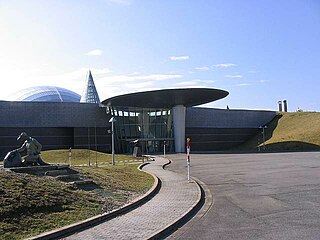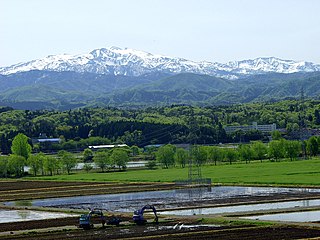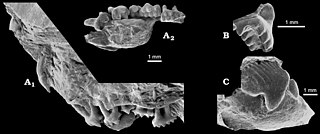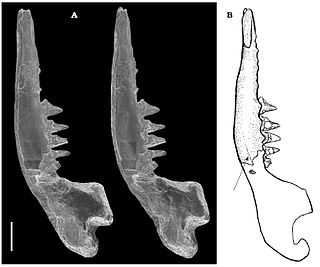Albionbaataridae is a family of small, extinct mammals within the order Multituberculata. Fossil remains are known from the Upper Jurassic and Lower Cretaceous of Europe and Asia. These herbivores lived their obscure lives during the Mesozoic, also known as the "age of the dinosaurs." They were among the more derived representatives of the informal suborder "Plagiaulacida". The taxon Albionbaataridae was named by Kielan-Jaworowska Z. and Ensom P.C. in 1994.
Eobaataridae is a family of fossil mammal within the order Multituberculata. Remains are known from the Lower Cretaceous of Europe and Asia. These herbivores thus lived during the Mesozoic era, also known as the "age of the dinosaurs". They were among the most derived representatives of the informal suborder "Plagiaulacida".

The Yixian Formation is a geological formation in Jinzhou, Liaoning, People's Republic of China, that spans 11 million years during the early Cretaceous period. It is known for its exquisitely preserved fossils, and is mainly composed of basalts interspersed with siliciclastic sediments.

Fukuisaurus is a genus of herbivorous dinosaur from the Early Cretaceous. It was an ornithopod which lived in what is now Japan.
Tritylodontidae is an extinct family of small to medium-sized, highly specialized mammal-like cynodonts, bearing several mammalian traits like erect limbs, endothermy and details of the skeleton. They were the last-known family of the non-mammalian synapsids, persisting into the Early Cretaceous.

The Fukui Prefectural Dinosaur Museum, located in Katsuyama, Fukui, Japan, is one of the leading dinosaur museums in Asia that is renowned for its exhibits of fossil specimens of dinosaurs and paleontological research. It is sited in the Nagaoyama Park near the Kitadani Dinosaur Quarry that the Lower Cretaceous Kitadani Formation of the Tetori Group is cropped out and a large number of dinosaur remains including Fukuiraptor kitadaniensis and Fukuisaurus tetoriensis are found and excavated.
The Kitadani Formation is a unit of Lower Cretaceous sedimentary rock which crops out near the city of Katsuyama in the Fukui Prefecture of Japan, and it is the primary source of Cretaceous-aged non-marine vertebrate fossils in Japan. Dinosaur remains are among the fossils that have been recovered from the formation, but it also preserves a diverse assemblage of plants, invertebrates, and other vertebrates. Most, if not all, of the fossil specimens collected from the Kitadani Formation are reposited at the Fukui Prefectural Dinosaur Museum.
Amphidon is an extinct genus of Late Jurassic mammal from the Morrison Formation. It is present in stratigraphic zone 5. The only species in the genus is Amphidon aequicrurius, found by Simpson in 1925.

Albalophosaurus is a genus of ceratopsian ornithischian dinosaur. It was described in 2009 from remains found in 1997 by Yoshinori Kobayashi from the Kuwajima Formation of central Japan, outcropping in Hakusan in the Ishikawa Prefecture. The holotype, SBEI 176, consists of cranial bones from an incomplete, disarticulated skull and left lower jaw thought to belong to a single individual. The type species is named A. yamaguchiorum. The generic name is derived from Latin albus, "white", and Greek λόϕος (lophos), "crest", a reference to the snow-covered crest of Mount Hakusan. The specific name honours Ichio Yamaguchi and Mikiko Yamaguchi, who discovered and prepared many fossils from the site.
The Amagodani Formation is an Early Cretaceous geologic formation in Japan. An indeterminate iguanodontian tooth has been recovered from the formation. as well as indeterminate pterosaur remains. Dinosaur footprints are also known from the formation.
The Kuwajima Formation is an Early Cretaceous geologic formation in Japan. Its precise age is uncertain due to a lack of identifying fossils, but it is probably Valanginian to Hauterivian in age. Dinosaur remains are among the fossils that have been recovered from the formation, including Albalophosaurus yamaguchiorum.
The Okurodani Formation is a Early Cretaceous geologic formation in central Honshu, Japan. Part of the Tetori Group, it primarily consists of freshwater continental sediments deposited in a floodplain environment, with occasional volcanic tuffite horizons. Dinosaur remains are among the fossils that have been recovered from the formation, although none have yet been referred to a specific genus. Many other fossil vertebrates are known from the KO2 locality
Liaobaatar changi is a multituberculate which existed in China during the lower Cretaceous period. It is the only species in the genus Liaobaatar.

Fukuititan is a genus of titanosauriform sauropod dinosaur that lived in the Early Cretaceous in what is now Japan. It is known from FPDM-V8468, the associated partial skeleton of a single individual, recovered from the Kitadani Dinosaur Quarry of the Tetori Group, at Katsuyama City. The type species, Fukuititan nipponensis, was described in 2010 by Japanese scientists Yoichi Azuma and Masateru Shibata of the Fukui Prefectural Dinosaur Museum. The discovery sheds light on Japanese titanosauriforms, which are poorly known in the region.
Xenocretosuchus is an extinct genus of tritylodont therapsids from the Aptian Ilek Formation of Siberia, in the Russian Federation. The type species, X. sibiricus, is known only from dental elements, as is X. kolossovi, described from the Batylykh Formation in 2008. Both species may be part of the genus Stereognathus.
Nipponoolithus is an oogenus of fossil egg native to Japan. It is one of the smallest known dinosaur eggs, and was probably laid by some kind of non-avian maniraptor.
Montirictus is an extinct genus of tritylodonts known from the Early Cretaceous Kuwajima Formation of Japan. It is currently the latest surviving tritylodontid species, and is closely relates to the earlier Xenocretosuchus from mainland Asia, and the Jurassic Stereognathus from the UK. It may be a species of the genus Stereognathus, but resolution of its affinities conditions upon the discovery of additional material.

Hakusanobaatar is an extinct genus of eobaatarid multituberculate which existed in Japan, during the early Cretaceous.
The Toyonishi Group is a group of Mesozoic rock strata in Japan, and was originally named by Tatsuro Matsumoto in 1949. It distributes in the southern half of Shimonoseki City, Yamaguchi Prefeture, southwest Japan, and deposited during the Uppermost Jurassic-Lower Cretaceous along the East Asian continental margin.

Symmetrolestes is an extinct genus of small spalacotheriid mammal from the Early Cretaceous period of Japan. The genus contains one species known as S. parvus, the type fossil is from fluvial deposits located in the Dinosaur Quarry in the Kitadani Formation, near the city of Katsuyama which lies alongside valley of the Sugiyamagawa River. It was described by Tsubamoto and Rougier in 2004 keeping the Holotype at the National Science Museum, Tokyo, Japan.






